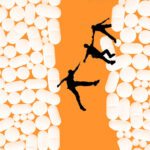Most people who take their own lives have no diagnosed mental illness. Connection and community may hold the only answers.
Some time ago Queensland Premier Annastacia Palaszczuk was forced to publicly defend her Health Minister, whose popularity was plummeting.
The problem, the Premier said, was that the health portfolio was “probably the most complex”.
Is it really the “most complex”, or simply the most politicised?
Each election is Groundhog Day: “Vote for us and we’ll fix health!” That narrative has not changed in the last 50 years, irrespective of who is in power. First you raise expectations, and then when you fail to deliver, blame complexity.
All models are wrong, but some are useful, to quote the statistician George Box. If your model is about delivering a fiscally responsible service to the community, then you need data that will demonstrate fiscal accountability. The complexity here is that the data comprise mainly surrogates, process measures, totally unrelated to community health outcomes. What they measure is often the extent of micromanagement of clinicians by middle management, and the perversity of the Commonwealth-state funding divide.
If your model presumes that healthcare is a ripe and ready political plaything to leverage support at the ballot box, then the model is about managing the political risk of reputational damage. So, you bang on additional rooms to the battered house and further paralyse the workforce with heavy documentation burdens, under the guise of “clinical governance”. For good measure you disguise these as overlapping and thus ambiguous legislative requirements; duty of care, code of conduct, health and guardianship Acts etc.
Doctors and their fellow clinicians are of course not entirely naïve to these false flags. Their rebuttal comes in the form of a new business plan, which naturally always requires more funding. This is where the term “complexity” morphs into “acuity”.
There are two components to acuity in a health context. The first is defined by objective features of the patient. The second is defined by the subjective inclination of the treating team. A hypervigilant team will be more prone to catastrophising, creating greater acuity.
In addition, greater fragmentation within healthcare is primed by the pump of generating greater competition for resources from within. Create some infighting within healthcare on the basis that competition is good. Presto, more complexity.
The health economist’s model could be that it’s all a chess game. They attempt to make prevention “sexy” and concentrate on population health measures and social indicators.
This may, with some irony, seem an overly complex way of leading you to my real subject, which is a particularly charged example of unhelpful overcomplication in the medical world.
“There is only one really serious philosophical problem,” Albert Camus said, “and that is suicide.2” Any death by suicide is a human tragedy. Fifty years ago, the rate of adolescent male suicide in Australian rural communities was 20-24 per 100,000. Today is much the same. So, what have we done?
A young man dies, a family grieves. At regular intervals, that grief translates into a burning platform for change. The target is the health minister. The minister refers the matter to the mental health public service moguls. They handball it to their central educators. Suicide is medicalised, and the “m” in medicalised slowly drifts from lower case to upper case, to upper case bold. With it, medical “acuity” is boosted.
It is true that serious psychiatric illnesses such as schizophrenia and bipolar carry a high risk of suicide. But 90% or more of those who take their own lives do not have a diagnosed mental illness. It’s a response to a human experiencing an existential crisis. I do not wish to minimise the magnitude of the crisis and the emotional anguish caused. But philosophically, the crisis is a transient mental inference.
I recently attended a train-the-trainer course call SRAM-ED. The acronym stands for Suicide Risk Assessment and Management for Emergency Department Settings. The course designers have done a terrific job. Two hours of e-learning followed by seven hours of face-to-face and simulations. What did I learn?
Humans faced with an existential crisis disconnect and therefore need human connection. For a plethora of reasons, normal folk have met up with a hyper-challenging and yet normal set of life circumstances and felt shame, guilt, and hopelessness. Forty per cent of senior school kids experience this. During covid, the same percentage of junior doctors experienced this. It’s normal. There is no reason for shame. Yet that is the disconnecting force.
I am sad that the acronym contains the words “risk” and “assessment”. To me those two words are distractors placed there to delay the critically needed treatment or “management”. These two scream out the political imperative; organisational reputational risk and assessment. But I digress.
So, what is the management?
The management of suicidality is something anyone should be able to do who is not directly emotionally involved. We spent a day learning how to drop our doctor or nurse cloak and be a human. We practised shedding our hard-earned medical expert skillsets simply to share respectful silence. A human prepared to be non-judgmental, listen and most importantly validate. To assuage the guilt and shame. To offer authentic connection.
We have medicalised a normal condition for too long. I don’t know how many PhDs have been awarded to clever researchers who have come up with an even better risk assessment tool. Tools that add complexity, acuity but nothing to the human experience. Yet, no tool can predict the possibility of a person’s actions after the “assessment” is completed. Life is skittish.
This suicide phenomenon will only be solved by the community which has created it. In my view, it’s time for medicine and particularly psychiatry and EDs to bow out. It’s a “complexity” they don’t need.
Every day should be an “RU OK” day. Why not even wear crazy socks every day? If we are fair dinkum about embracing diversity, then those with a greater sensitivity towards the slings and arrows of existence should be accepted and even honoured. Healthcare should not have to be an apologist for society’s inhumanity towards itself. It’s that simple.
As for the rest of the “complexity”, I think healthcare has too many masters. It’s time to divest of some. Who wants to volunteer?
Associate Professor Kees Nydam was at various times an emergency physician and ED director in Wollongong, Campbeltown and Bundaberg. He continues to work as a senior specialist in addiction medicine and to teach medical students attending the University of Queensland Rural Clinical School. He is also a poet and songwriter.





